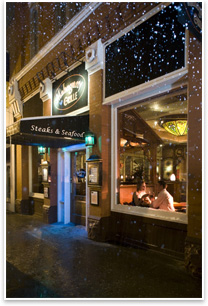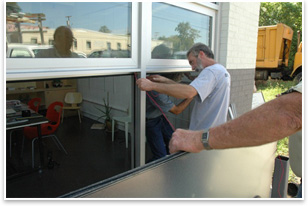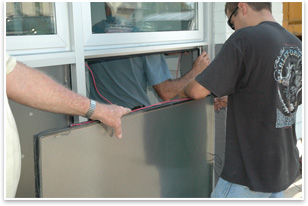Hot Off the Grill
Heated windows eliminate draft at Durango restaurant, provide energy savings
by Russell Boniface
Associate Editor
 How do you . . . use new window technology to increase comfort, views, and energy efficiency? How do you . . . use new window technology to increase comfort, views, and energy efficiency?
Summary: The Mahogany Grille in downtown Durango, Colo., claims it is the first restaurant in North America to adopt heated windows to eliminate draft. The restaurant installed a technology called Thermique™ that transforms two front windows—each measuring 42 square feet of glass—into a radiant heat source. The two heated glass windows also provide condensation control to prevent them from fogging or frosting while the heat’s on, thus giving diners a clear view of the scenic downtown Durango at all times. Saving energy is also a significant benefit of the new windows.
 The Mahogany Grille, an upscale restaurant located in downtown Durango’s historic landmark Strater Hotel, avoided the draft by working with Chicago-based Thermique Technologies in Chicago to create heated windows for the front of the restaurant. For installation, the Mahogany Grille called upon Aspen, Colo.-based Colorado Warm Windows, which retrofitted electrical components hidden within the window frame to avoid altering the Victorian appearance of the window or the building. The cost of each window installed was approximately $4,000. The Mahogany Grille, an upscale restaurant located in downtown Durango’s historic landmark Strater Hotel, avoided the draft by working with Chicago-based Thermique Technologies in Chicago to create heated windows for the front of the restaurant. For installation, the Mahogany Grille called upon Aspen, Colo.-based Colorado Warm Windows, which retrofitted electrical components hidden within the window frame to avoid altering the Victorian appearance of the window or the building. The cost of each window installed was approximately $4,000.
The heat is on
“We are breaking some interesting ground with this technology,” says George Usinowicz, Thermique Technologies’ architectural representative. “It’s old technology, but the time has come to introduce it into building envelopes and building sciences.”
 The Mahogany Grille’s windows radiate heat but stay transparent because of a coating bonded to the glass. The coating, a thin transparent oxide, generates heat when subjected to an electrical current supplied by copper busbars on opposite sides of the glass. Wiring connects the busbars to a light-switch-style, wall-mounted controller. “When the electrical current is introduced to one busbar on one leg of the glass window, it travels through the metal oxide because metal conducts and resists electrical current,” explains Usinowicz. “As the current flows through the metal oxide, its meeting resistance, thereby producing resistance heat. Because the glass is warm, the glass itself radiates heat uniformly. The heated glass temperature can go as high as 105 degrees Fahrenheit.” The Mahogany Grille’s windows radiate heat but stay transparent because of a coating bonded to the glass. The coating, a thin transparent oxide, generates heat when subjected to an electrical current supplied by copper busbars on opposite sides of the glass. Wiring connects the busbars to a light-switch-style, wall-mounted controller. “When the electrical current is introduced to one busbar on one leg of the glass window, it travels through the metal oxide because metal conducts and resists electrical current,” explains Usinowicz. “As the current flows through the metal oxide, its meeting resistance, thereby producing resistance heat. Because the glass is warm, the glass itself radiates heat uniformly. The heated glass temperature can go as high as 105 degrees Fahrenheit.”
 Usinowicz says there are four dynamics of heated glass. “The first thing that radiant heating glass does for architecture is that it neutralizes radiant heat transfer out of the occupant. Second, it stops draft. Third, there is no condensation on glass, because all the glass surface temperature needs to do is be one degree of over room temperature. And fourth, there is a soft amount of infrared heat.” Usinowicz says there are four dynamics of heated glass. “The first thing that radiant heating glass does for architecture is that it neutralizes radiant heat transfer out of the occupant. Second, it stops draft. Third, there is no condensation on glass, because all the glass surface temperature needs to do is be one degree of over room temperature. And fourth, there is a soft amount of infrared heat.”
Seating customers by the heated windows helps a restaurant recover square footage through increased floor space in the dining area, Usinowicz adds.
Potential energy savings
“We use a modest amount of energy, but it’s absolutely energy-saving in the long run,” Usinowicz points out.
 Each of the Mahogany Grille’s two front windows is 42 square feet of glass. On a 6- degree F night in Durango, each window uses the equivalent of six 100-watt light bulbs, to heat the glass up to 85 degrees, he says. “If you change the 6-degree F night to a 25- degree night, you would need the equivalent of four 100-watt light bulbs to take the glass up to 81 degrees. Either way, it’s not a lot of energy to heat the glass.” Each of the Mahogany Grille’s two front windows is 42 square feet of glass. On a 6- degree F night in Durango, each window uses the equivalent of six 100-watt light bulbs, to heat the glass up to 85 degrees, he says. “If you change the 6-degree F night to a 25- degree night, you would need the equivalent of four 100-watt light bulbs to take the glass up to 81 degrees. Either way, it’s not a lot of energy to heat the glass.”
He compares its energy use to space heaters. “We have 1000-watt heaters at our feet. For 60 percent of the energy used by a heater, we can heat the restaurants’ window tables, which in the long run saves energy for the restaurant compared to having to turn up the heat of the entire restaurant in order for its patrons at those tables to be comfortable. It’s also energy-saving in that you don’t need to put heated glass everywhere.”
Usinowicz thinks that heated glass technology could have a major impact on the future of building sciences. “I sincerely believe that this is a forward-moving technology that brings a better understanding about the effect of glass on occupants’ comfort, and the solutions that heated glass can bring to control that comfort.”
|


 How do you . . .
How do you . . . The Mahogany Grille, an upscale restaurant located in downtown Durango’s historic landmark Strater Hotel, avoided the draft by working with Chicago-based Thermique Technologies in Chicago to create heated windows for the front of the restaurant. For installation, the Mahogany Grille called upon Aspen, Colo.-based Colorado Warm Windows, which retrofitted electrical components hidden within the window frame to avoid altering the Victorian appearance of the window or the building. The cost of each window installed was approximately $4,000.
The Mahogany Grille, an upscale restaurant located in downtown Durango’s historic landmark Strater Hotel, avoided the draft by working with Chicago-based Thermique Technologies in Chicago to create heated windows for the front of the restaurant. For installation, the Mahogany Grille called upon Aspen, Colo.-based Colorado Warm Windows, which retrofitted electrical components hidden within the window frame to avoid altering the Victorian appearance of the window or the building. The cost of each window installed was approximately $4,000. The Mahogany Grille’s windows radiate heat but stay transparent because of a coating bonded to the glass. The coating, a thin transparent oxide, generates heat when subjected to an electrical current supplied by copper busbars on opposite sides of the glass. Wiring connects the busbars to a light-switch-style, wall-mounted controller. “When the electrical current is introduced to one busbar on one leg of the glass window, it travels through the metal oxide because metal conducts and resists electrical current,” explains Usinowicz. “As the current flows through the metal oxide, its meeting resistance, thereby producing resistance heat. Because the glass is warm, the glass itself radiates heat uniformly. The heated glass temperature can go as high as 105 degrees Fahrenheit.”
The Mahogany Grille’s windows radiate heat but stay transparent because of a coating bonded to the glass. The coating, a thin transparent oxide, generates heat when subjected to an electrical current supplied by copper busbars on opposite sides of the glass. Wiring connects the busbars to a light-switch-style, wall-mounted controller. “When the electrical current is introduced to one busbar on one leg of the glass window, it travels through the metal oxide because metal conducts and resists electrical current,” explains Usinowicz. “As the current flows through the metal oxide, its meeting resistance, thereby producing resistance heat. Because the glass is warm, the glass itself radiates heat uniformly. The heated glass temperature can go as high as 105 degrees Fahrenheit.” Usinowicz says there are four dynamics of heated glass. “The first thing that radiant heating glass does for architecture is that it neutralizes radiant heat transfer out of the occupant. Second, it stops draft. Third, there is no condensation on glass, because all the glass surface temperature needs to do is be one degree of over room temperature. And fourth, there is a soft amount of infrared heat.”
Usinowicz says there are four dynamics of heated glass. “The first thing that radiant heating glass does for architecture is that it neutralizes radiant heat transfer out of the occupant. Second, it stops draft. Third, there is no condensation on glass, because all the glass surface temperature needs to do is be one degree of over room temperature. And fourth, there is a soft amount of infrared heat.” Each of the Mahogany Grille’s two front windows is 42 square feet of glass. On a 6- degree F night in Durango, each window uses the equivalent of six 100-watt light bulbs, to heat the glass up to 85 degrees, he says. “If you change the 6-degree F night to a 25- degree night, you would need the equivalent of four 100-watt light bulbs to take the glass up to 81 degrees. Either way, it’s not a lot of energy to heat the glass.”
Each of the Mahogany Grille’s two front windows is 42 square feet of glass. On a 6- degree F night in Durango, each window uses the equivalent of six 100-watt light bulbs, to heat the glass up to 85 degrees, he says. “If you change the 6-degree F night to a 25- degree night, you would need the equivalent of four 100-watt light bulbs to take the glass up to 81 degrees. Either way, it’s not a lot of energy to heat the glass.”